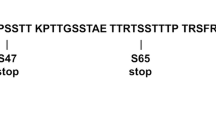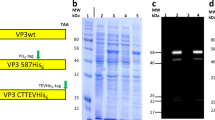Abstract
The interesting discovery reported here that soluble adenovirus serotype 5 (Ad5) fiber proteins enter cells without the virus was a serendipitous result during our development of Ad5 capsid proteins as nonviral gene transfer vectors. The Ad5 capsid fiber and penton proteins mediate infection. The fiber docks to a noninternalizing cell surface protein called the coxsackievirus-Ad receptor (CAR), followed by penton binding to integrins, triggering integrin-mediated endocytosis of the virus. In our previous work, we assembled the nonviral complex, 3PO, which utilized the penton to mediate gene transfer through integrin binding and endocytosis. Here, we tested whether incorporating the fiber targets 3PO to CAR, thus recapitulating the Ad5 infection pathway. As CAR is not an endocytic receptor, we were surprised to find that the fiber alone, without the penton, enabled gene transfer by binding CAR, but internalizing through an unknown mechanism. We show here that the fiber distributes to the nucleus and cytoplasm after temperature-independent uptake, whereas the penton accumulates around the nucleus after temperature-dependent uptake. Fiber uptake by HeLa cells is also actin-dependent, requires the fiber tail/shaft region, and is largely inhibited by heparin. This study raises the possibility that alternative pathways may enable both viral and nonviral cell entry.
This is a preview of subscription content, access via your institution
Access options
Subscribe to this journal
Receive 12 print issues and online access
$259.00 per year
only $21.58 per issue
Buy this article
- Purchase on Springer Link
- Instant access to full article PDF
Prices may be subject to local taxes which are calculated during checkout








Similar content being viewed by others
References
Brody SL, Crystal RG . Adenovirus-mediated in vivo gene transfer. Ann NY Acad Sci 1994; 716: 90–101; discussion 101–103.
Kozarsky KF, Wilson JM . Gene therapy: adenovirus vectors. Curr Opin Genet Dev 1993; 3: 499–503.
Boudin ML, Boulanger P . Assembly of adenovirus penton base and fiber. Virology 1982; 116: 589–604.
Devaux C et al. Structure of adenovirus fibre. I. Analysis of crystals of fibre from adenovirus serotypes 2 and 5 by electron microscopy and X-ray crystallography. J Mol Biol 1990; 215: 567–588.
Novelli A, Boulanger PA . Deletion analysis of functional domains in baculovirus-expressed adenovirus type 2 fiber. Virology 1991; 185: 365–376.
Henry LJ et al. Characterization of the knob domain of the adenovirus type 5 fiber protein expressed in Escherichia coli. J Virol 1994; 68: 5239–5246.
Xia D, Henry LJ, Gerard RD, Deisenhofer J . Crystal structure of the receptor-binding domain of adenovirus type 5 fiber protein at 1.7 A resolution. Structure 1994; 2: 1259–1270.
Bergelson JM et al. Isolation of a common receptor for Coxsackie B viruses and adenoviruses 2 and 5. Science 1997; 275: 1320–1323.
Wickham TJ, Mathias P, Cheresh DA, Nemerow GR . Integrins αvβ3 and αvβ5 promote adenovirus internalization but not virus attachment. Cell 1993; 73: 309–319.
Mathias P, Wickham T, Moore M, Nemerow G . Multiple adenovirus serotypes use αv integrins for infection. J Virol 1994; 68: 6811–6814.
Cohen CJ et al. The coxsackievirus and adenovirus receptor is a transmembrane component of the tight junction. PNAS Early Edition 2001: 1–6; www.pnas.org/cgi/doi/10.1073/pnas.261452898.
Medina-Kauwe LK, Kasahara N, Kedes L . 3PO, a novel non-viral gene delivery system using engineered Ad5 penton proteins. Gene Therapy 2001; 8: 795–803.
Karayan L, Gay B, Gerfaux J, Boulanger PA . Oligomerization of recombinant penton base of adenovirus type 2 and its assembly with fiber in baculovirus-infected cells. Virology 1994; 202: 782–795.
Medina-Kauwe LK, Leung V, Wu L, Kedes L . Assessing the binding and endocytosis activity of cellular receptors using GFP–ligand fusions. BioTechniques 2000; 29: 602–609.
Mitraki A ; et al. Unfolding studies of human adenovirus type 2 fibre trimers. Evidence for a stable domain. Eur J Biochem 1999; 264: 599–606.
Hong JS, Engler JA . Domains required for assembly of adenovirus type 2 fiber trimers. J Virol 1996; 70: 7071–7078.
Medina-Kauwe LK, Maguire M, Kasahara N, Kedes L . Non-viral gene delivery to human breast cancer cells by targeted Ad5 penton proteins. Gene Therapy 2001; 8: 1753–1761.
Defer C, Belin MT, Caillet-Boudin ML, Boulanger P . Human adenovirus–host cell interactions: comparative study with members of subgroups B and C. J Virol 1990; 64: 3661–3673.
Persson R, Wohlfart C, Svensson U, Everitt E . Virus–receptor interaction in the adenovirus system: characterization of the positive cooperative binding of virions on HeLa cells. J Virol 1985; 54: 92–97.
Gottschalk S et al. A novel DNA–peptide complex for efficient gene transfer and expression in mammalian cells. Gene Therapy 1996; 3: 48–57.
Medina-Kauwe LK . Endocytosis of adenovirus and adenovirus capsid proteins. Adv Drug Deliv Rev 2003; 55: 1485–1496.
Medina-Kauwe LK, Chen X . Using GFP–ligand fusions to measure receptor-mediated endocytosis in living cells. In: Litwack G (ed). Vitamins and Hormones. Elsevier Science: San Diego, 2002; pp 81–95.
Dechecchi MC, Tamanini A, Bonizzato A, Cabrini G . Heparan sulfate glycosaminoglycans are involved in adenovirus type 5 and 2-host cell interactions. Virology 2000; 268: 382–390.
Miyazawa N et al. Fiber swap between adenovirus subgroups B and C alters intracellular trafficking of adenovirus gene transfer vectors. J Virol 1999; 73: 6056–6065.
Zhang F et al. A transfecting peptide derived from adenovirus fiber protein. Gene Therapy 1999; 6: 171–181.
Console S et al. Antennapedia and HIV transactivator of transcription (TAT) ‘protein transduction domains’ promote endocytosis of high molecular weight cargo upon binding to cell surface glycosaminoglycans. J Biol Chem 2003; 278: 35109–35114.
Rabinowitz JE et al. Cross-packaging of a single adeno-associated virus (AAV) type 2 vector genome into multiple AAV serotypes enables transduction with broad specificity. J Virol 2002; 76: 791–801.
Lundberg M, Wikstrom S, Johansson M . Cell surface adherence and endocytosis of protein transduction domains. Mol Ther J Am Soc Gene Ther 2003; 8: 143–150.
Meier O et al. Adenovirus triggers macropinocytosis and endosomal leakage together with its clathrin-mediated uptake. J Cell Biol 2002; 158: 1119–1131.
Orlandi PA, Fishman PH . Filipin-dependent inhibition of cholera toxin: evidence for toxin internalization and activation through caveolae-like domains. J Cell Biol 1998; 141: 905–915.
West MA, Bretscher MS, Watts C . Distinct endocytotic pathways in epidermal growth factor-stimulated human carcinoma A431 cells. (erratum appears in J Cell Biol 1990 Mar;110(3):859). J Cell Biol 1989; 109: 2731–2739.
Bantel-Schaal U, Hub B, Kartenbeck J . Endocytosis of adeno-associated virus type 5 leads to accumulation of virus particles in the Golgi compartment. J Virol 2002; 76: 2340–2349.
Hautala T et al. An interaction between penton base and alpha v integrins plays a minimal role in adenovirus-mediated gene transfer to hepatocytes in vitro and in vivo. Gene Therapy 1998; 5: 1259–1264.
Albinsson B, Kidd AH . Adenovirus type 41 lacks an RGD alpha(v)-integrin binding motif on the penton base and undergoes delayed uptake in A549 cells. Virus Res 1999; 64: 125–136.
Chillon M, Kremer EJ . Trafficking and propagation of canine adenovirus vectors lacking a known integrin-interacting motif. Hum Gene Ther 2001; 12: 1815–1823.
Soudais C et al. Canine adenovirus type 2 attachment and internalization: coxsackievirus-adenovirus receptor, alternative receptors, and an RGD-independent pathway. J Virol 2000; 74: 10639–10649.
Laemmli UK . Cleavage of structural proteins during the assembly of the head of bacteriophage T4. Nature 1970; 227: 680–685.
Acknowledgements
This study was supported by grants to Dr Medina-Kauwe from the NIH (R01 CA102126-01) and the USC Research Center for Liver Disease Institutional Research Grant allocation (P30 DK48522-08). A grant to Dr Hamm-Alvarez and Dr Medina-Kauwe from the NIH (RO3 EY13949-01) also supported this work. We are grateful to the USC Confocal Core Facility (supported by P30 DK48522) and Flow Cytometry Lab for their assistance and use of their facilities. We also thank the following people for their helpful discussions: Maria Castro, Noriyuki Kasahara, Pedro Lowenstein, and members of the Hamm-Alvarez and Kedes labs.
Author information
Authors and Affiliations
Rights and permissions
About this article
Cite this article
Rentsendorj, A., Agadjanian, H., Chen, X. et al. The Ad5 fiber mediates nonviral gene transfer in the absence of the whole virus, utilizing a novel cell entry pathway. Gene Ther 12, 225–237 (2005). https://doi.org/10.1038/sj.gt.3302402
Received:
Accepted:
Published:
Issue Date:
DOI: https://doi.org/10.1038/sj.gt.3302402
Keywords
This article is cited by
-
Typical and atypical trafficking pathways of Ad5 penton base recombinant protein: implications for gene transfer
Gene Therapy (2006)
-
Intracellular trafficking of nonviral vectors
Gene Therapy (2005)



